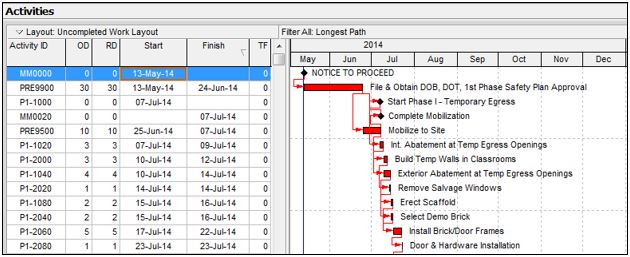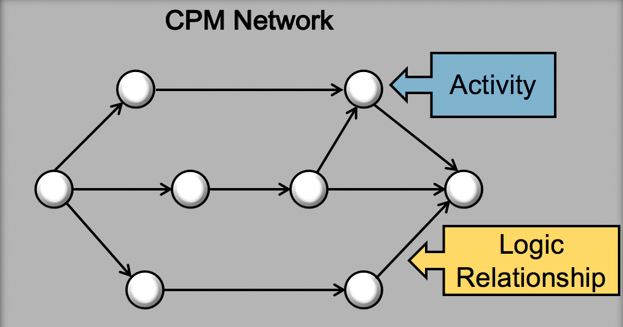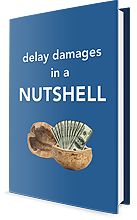The Essential Elements of Modern Critical Path Method (CPM) Schedules
The type of schedule we most often recommend for your construction project is a CPM schedule. There are several elements you’ll see in every CPM schedule.
In technical terms, a CPM schedule models the project’s plan for construction in a network. This CPM schedule network consists of activities, which represent the project’s work scope, and logic relationships, which connect the activities to another, that together depict the project’s construction sequence and forecasts when the project will finish.
Critical Path
The critical path is the longest path of activities in the schedule network that forecasts when the project will finish. What does that mean? That means that everything we do has a critical path, whether it’s building a construction project, getting to work, or cooking Thanksgiving dinner. What the CPM schedule allows us to do is identify what that critical path is. It’s essential to properly identify the project’s critical path, because only delays to the project’s critical path will delay the project’s completion.
Data Date

Every CPM schedule will have a data date.
The data date, which was the vertical blue line in the above screenshot, represents the date from which the schedule is calculated. Over the course of a project (as the project starts and the contractor makes progress), that vertical data date line will move forward in time.
If the CPM schedule is updated on a monthly basis, we’ll see that vertical line move 30 days forward in time every month. As the project progresses, all the activities to the left of the vertical data date line will represent the actual start and finish dates of the work, and everything to the right of the data date will project or forecast the start and finish dates of the remaining uncompleted work.
Activity Durations

In CPM schedules, each activity (represented as a bar) will have a duration (time). The length of the bar represents the amount of time required to complete an activity. An activity’s duration is depicted as either an original duration or remaining duration. In the chart above, they are identified as “OD” and “RD.”
An original duration is the estimated or planned amount of time necessary to complete a work activity. In the image above, the activity highlighted in blue is an original duration of 10 days. That means the contractor originally planned, or expected it to take 10 days, to mobilize the site.
If you look at the bar chart portion of the above screenshot, you’ll notice that the blue vertical data date line is at the end of the month of June. Everything to the left of the vertical blue data date line is blue, and everything to the right is red.
In this case, everything to the left is actual. If you look closely at the dates, you’ll see some capital A’s at the end of the start and finish dates of the activities.
Everything that’s not completed does not have that A. That A means that the start and finish dates are actual dates, and the remaining duration represents the amount of time the contractor needs to complete the work once an activity starts.
In this case, that mobilized site activity has a remaining duration (RD) of 7 days, which means from the start date of June 25th to the schedule’s data date, the contractor accomplished 3 days of work on this activity and it has 7 more days to complete it.
Logic Relationships

As stated earlier, a CPM schedule is a combination of two things:
- Activities that represent the work scope.
- The relationships between those activities that determine the sequence in which those work activities will be completed.
When we talk about logic relationships, there are four relationship types:
- Finish-to-Start: When one activity finishes, its successor can start.
- Start-to-Start: When one activity starts, its successor can begin.
- Finish-to-Finish: When one activity finishes, its successor can also finish, but not until then.
- Start-to-Finish: When one activity starts, its successor can finish.
Note: If I see a Start-to-Finish relationship in a CPM schedule, I question whether that was an error, or whether the scheduler may not know what he or she is doing.
Work Calendars
Another essential component of a CPM schedule is that it must also contain work calendars.
There are different ways that contractors can perform the work on a project, in terms of how often they work and how long they work on a given day. A typical default work calendar is a 5-day per week, 8-hour per day, work-week calendar. Typically, when you open or prepare a schedule, it’s developed on that basis.
I’ve worked with contractors who only work 4, 10-hour per day work weeks rather than a typical 5, 8-hour per day work week. They believe if they work their crew 4 days per week, they can eliminate one unnecessary mobilization and demobilize at the end of the day.
Additionally, there are also work activities that only occur on a calendar-day basis. On projects that involve the placement of concrete, there is often a required cure time for concrete, which is typically 7 to 14 days. In these instances, the schedule should include an activity representing that concrete curing duration. This curing activity should be assigned to a 7-day work week calendar so that we can properly represent the time needed to cure that concrete 7 days per week.
Keep in mind that your project completion milestones are typically tied to liquidated damages, or incentives, and usually calculated on a calendar-day basis. Therefore, project completion milestone activities should be assigned to calendar-day work calendars. The use of multiple work calendars also allows us to account for winter shutdowns, and environmental work restrictions such that the schedule incorporates when work cannot occur at specific times of the year.
Activity Dates
Activity dates are another important element of a CPM schedule. Every activity with a duration (which means it takes more than at least a day to complete) will have four types of dates. We’ll have an early start, an early finish, a late start, and a late finish date. These are called early dates and late dates.
These early and late dates are calculated on what the CPM calculation calls the forward and backward passes. The early dates represent the earliest an activity can start or finish, and the late dates are the latest date an activity can start or finish and not delay the project.
Mark Nagata is a Director/Shareholder of TRAUNER and is an expert in the areas of critical path method scheduling, delay and inefficiency analysis, and construction claim preparation and evaluation.
He loves to get questions at mark.nagata@traunerconsulting.com.
If you liked this article, be sure to sign up on the left side of our website to receive our Ideas & Insights in your email. Be sure to check your email after signing up.

